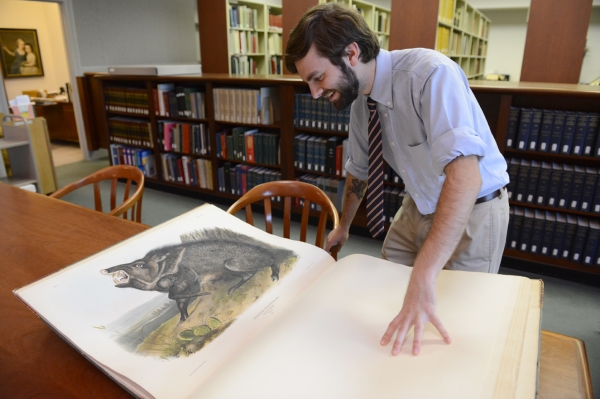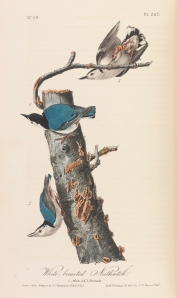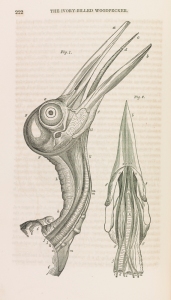Audubon at the Virginia Historical Society
When I began my time at the Virginia Historical Society as a library clerk, I was thrilled to find a first edition of John James Audubon’s Viviparous Quadrupeds (Rare Books folio QL715 .A916 1845) in the rare books collection. Audubon has always been one of my favorite historical figures, and his pioneering contributions toward natural history, art, and conservation are still extremely influential today. Viviparous Quadrupeds is a spectacular set of illustrations of mammals and already the subject of an excellent Virginia History Explorer article.
To my delight, another rare Audubon collection made its way to the VHS several months ago: the 1st Octavo edition of Audubon’s The Birds of America (Rare Books QL674 .A92 1840/44). As a shameless bird enthusiast, I pounced on the opportunity to explore these books in more detail. Audubon’s original Birds of America is his most famous work and consisted of 435 hand-illustrated prints measuring roughly 39 by 29 inches. The work was published from 1827 to 1838 in installments to subscribers, and only 119 copies are known to still exist. These books are extremely valuable today, and of the ten most expensive books of all time, five are The Birds of America.[1]
The Royal Octavo edition of Birds of America was Audubon’s attempt to make his work available to a wider audience. Published between 1839 and 1844, the Royal Octavo consisted of seven smaller volumes and combined the plates with text from Ornithological Biography, which was written to accompany The Birds of America but was published separately. It added some new species, which brought the total number of plates to 500, and it replaced the etching of the original prints with stone lithography. The new volumes were more financially successful for Audubon and allowed him to enjoy the rest of his life in relative prosperity.
Audubon’s images are the undeniable stars of the volumes, but the accompanying text makes for an interesting and often entertaining read. Though Audubon’s work has plenty of mistakes, his correct discoveries and insightful observations far outnumber them and are often revealed in both his plates and texts, such as with the White-Breasted Nuthatch: ‘It moves alertly, however, when searching for food, climbing or retrograding downwards or sidewise, with cheerfulness and
a degree of liveliness, which distinguish it at once from other birds.” Audubon combined his description with a perfect illustration (Nuthatch #2) of this distinctive behavior. The Royal Octavos are also home to Audubon’s less heralded but still quite excellent anatomical sketches, such as this Ivory Billed Woodpecker.
We also find evidence of Audubon’s love and appreciation of nature and some eloquent passages in favor of conservation. His defense of the American Crow, a frequently reviled bird, is a lengthy and persuasive paragraph, concluding with the plea, “I cannot but wish that they would reflect a little, and become more indulgent toward our poor, humble, harmless, and even most serviceable bird, the Crow.” His sentiments, however, were apparently tempered with pragmatism, as he later noted: “In conclusion, I would again address our farmers, and tell them that if they persist in killing Crows, the best season for doing so is when their corn begins to ripen.”
These Royal Octavo editions, though not nearly as rare or valuable as his original folio editions, provide a fantastic opportunity to enjoy Audubon’s art and writing through an exciting piece of history. They are freely available for the general public to enjoy in our research library.
[1]The Economist Online. 8 December 2010. http://www.economist.com/blogs/dailychart/2010/12/books
Tony Walters is a library clerk at the Virginia Historical Society.










Trackbacks